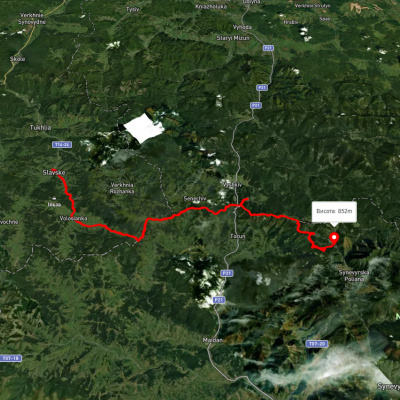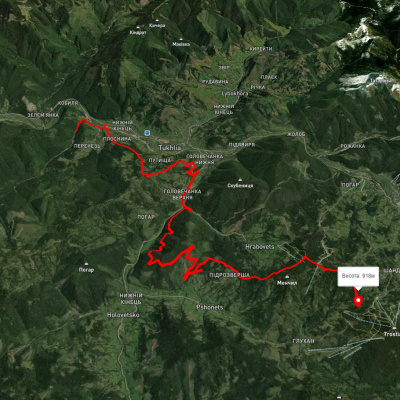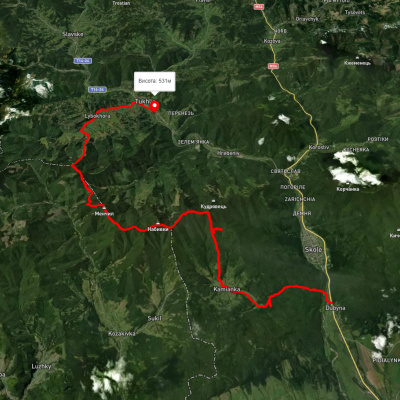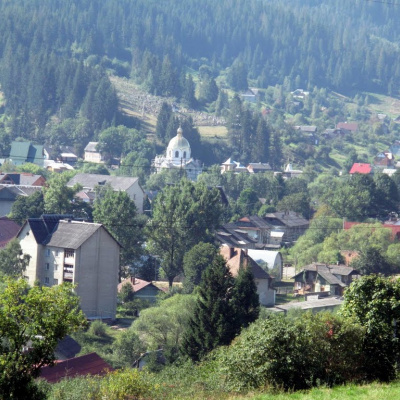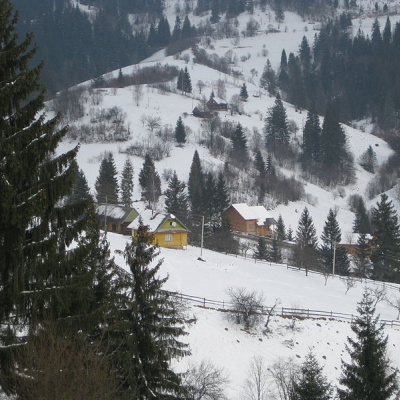Slavske
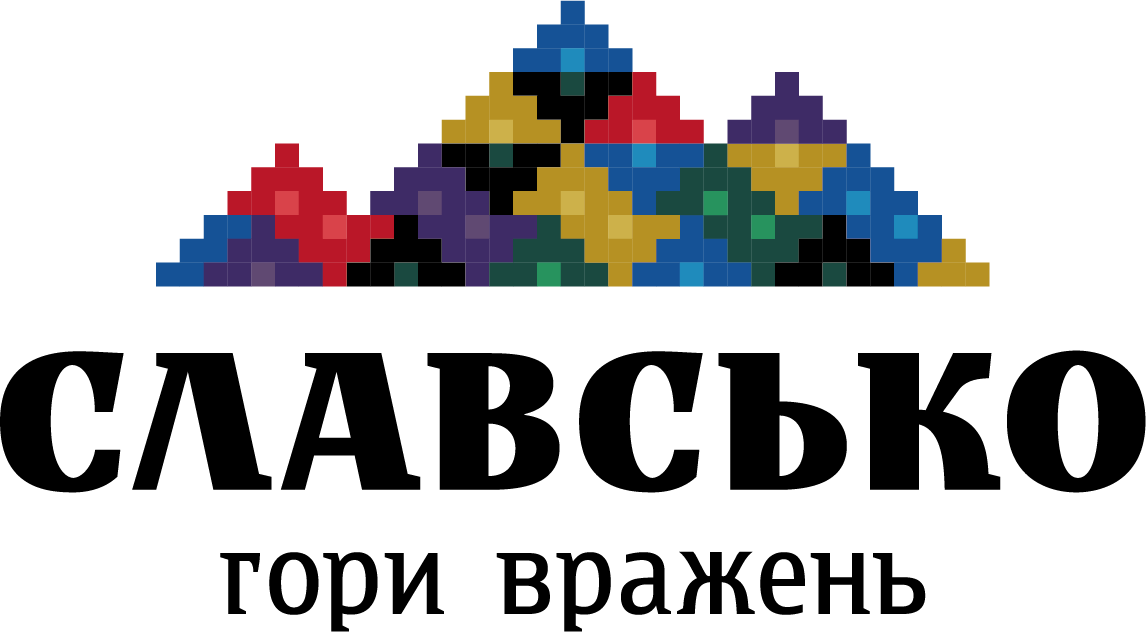
Slavske (Slavsko) is an incredible mountain village. Some people believe that its beauty is not inferior to the Alpine resorts. Slavske is an urban-type settlement in the Skole district of Lviv region and the center of the Slavske settlement amalgamated territorial community. It is one of the most popular ski resorts in the Ukrainian Carpathians. The resort is located in the picturesque valley of the Opir and Slavka rivers, at an altitude of 600 m above sea level, deep in the Ukrainian Carpathians, 28 km from Skole, among the forested and mountain meadows of the Beskydy and Gorgany ranges, on the slopes of Trostyan (1235 m above sea level), Ilya (1066 m), Pysana or Dovbushanka (1236 m), and Menchel (1014 m), which surround the village from all sides. To the north of the village rises Mount Klyva (1069 m).
The highest peaks are Kycherka (845 m), Plai (876 m), Pryslip (990 m), Plishka (1038 m), Ilza (1066 m), Klyva (1069 m), Pysana Krynytsia or Dovbushanka (1236 m), Vysokyi Verkh (1245 m), Trostyan (1235 m).
Flint tools of the Neolithic period were found on the territory of Slavske. According to the Ukrainian historian Venedikt Ploshchansky, the first settlers appeared in the village around the 10th century. Ploschansky emphasizes the ancient origin of Slavske: "Slavsko," he writes, "is an ancient village, lying on the ancient route from Halych (via Synevidsko) to Hungary.
As for the origin of the name of the village and the river Slavka, it is most likely that it comes from the nickname "glorious", which was given to the population of the surrounding area for their participation in the campaigns of the vigilantes of Prince Sviatoslav Volodymyrovych, who was killed above the Opor between Skole and Hrebenove during the princely strife (in 1015). According to the legends passed down from generation to generation, the surviving vigilantes of Prince Sviatoslav did not return to their native places but settled in the mountains above Opor, in particular near the confluence of the Slavka River.
Slavsko was first mentioned in documentary sources in 1483 as an existing settlement. The records of the Przemysl Zemstvo Court mention that the nobleman Ivanko from Krynytsia formalized in writing the right of his wife Marusia to half of his property in Krynytsia and Slavsko in the Przemysl district.
Noblemen's attacks and robberies in the 16th and 17th centuries were sometimes so horrific, bloody, and unpunished that even the Polish historian Władysław Łoziński wrote with indignation when talking about them: "What a world, what a world! Dark, wild, murderous. A world without government, without order, without justice, and without mercy. Blood is cheaper than wine, a man is cheaper than a horse. A world in which it is easy to kill, hard not to be killed."
The unbearable feudal oppression forced the peasants to fight. Many Verkhovyna residents joined the opryshky, who terrified the nobility and its servants for more than three centuries. In particular, in the Beskydy region, an opryshky unit led by a former shepherd, Andrii Dzyganovych, fought for almost ten years (1671-1681). On the mountain that rises near the village, the opryshka Oleksa Dovbush took refuge in a cave (hence the current name of the mountain, Dovbushanka).
After the first partition of Poland, Galicia became part of the Habsburg Empire (since 1804 - the Austrian Empire). From 1820, Slavsko belonged to the Polish count Potocki, who intensified the ruthless exploitation of the peasants. In the last quarter of the nineteenth century, a railroad was laid through Slavsko, connecting Skole with Mukachevo. The first train ran along this line on April 4, 1887.
Driven to despair by poverty, disenfranchisement, and lordly arbitrariness, the residents of Slavske and other surrounding villages took an active part in the anti-feudal uprising of 1824-1826 in the Skole district, which attracted the attention of Ivan Franko and Mykola Ustianovych. In 1901, the construction of a new church designed by Vasyl Nahirnyi was completed. On July 10 of that year, it was consecrated by Metropolitan Andrey Sheptytsky.
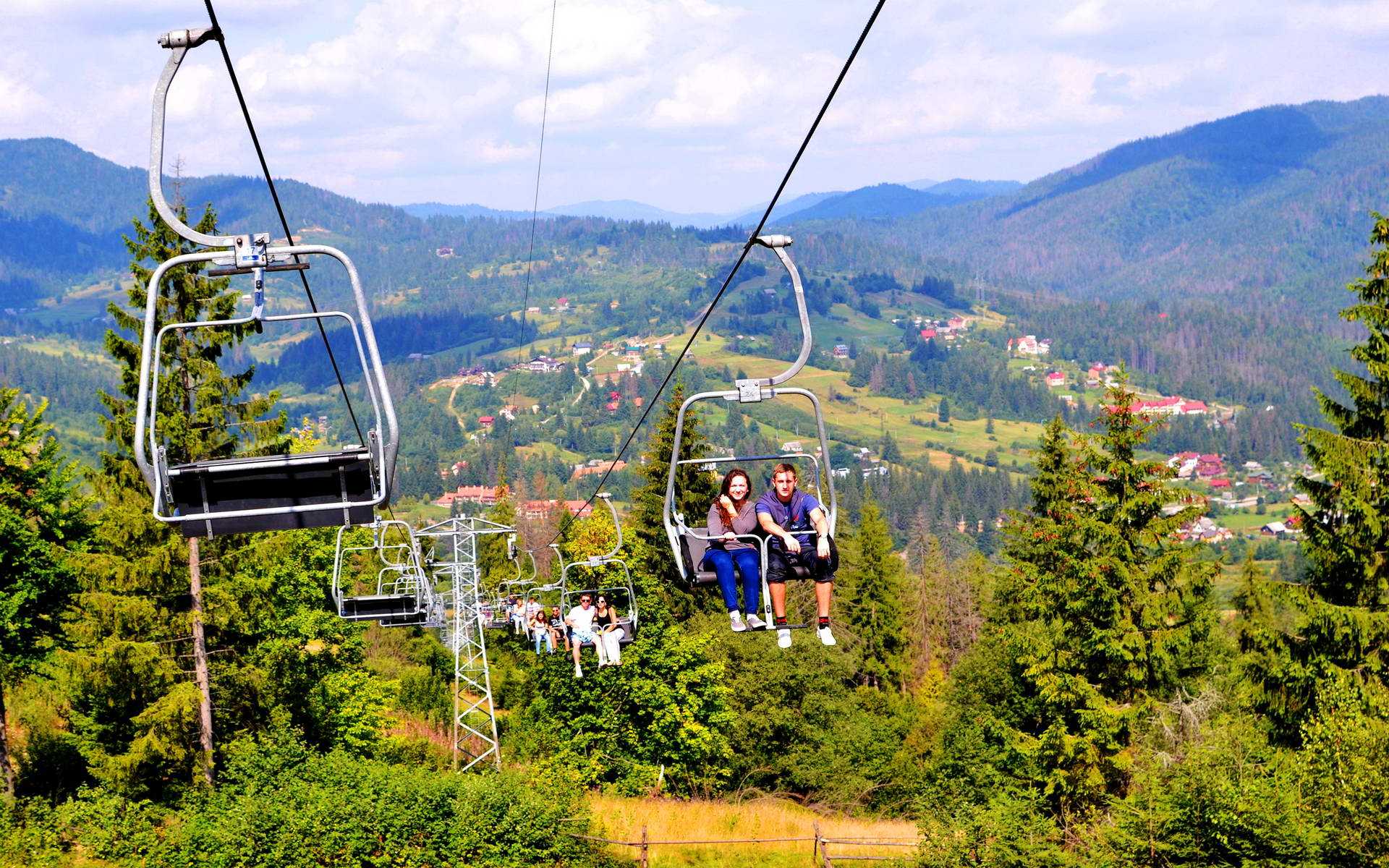
Near Slavske there are interesting natural monuments: one of the most beautiful waterfalls in Transcarpathia - the Shypit Waterfall (25 km), Dovbush Rocks in Bubnyshche (29 km), the Skole Beskydy National Nature Park (25 km), a unique example of Carpathian wooden architecture - the Church of St. Nicholas the Wonderworker in Podobovets (24 km). In summer, various festivals are often held here. One of them is the I Love the Carpathians rock festival.
About the ski resort
The tourist business in Slavske was started by the Grödl entrepreneurs, who opened hotels and a climatotherapy station in the XIX century. In the 1920s and 1930s, the Grödls and the Schmidts built ski lifts and ski jumps on Mount Pohar and Mount Ilza. Slavske experienced its greatest tourist development in the 1970s and 1980s, when more than 10 ski lifts were built and ski schools were founded.
In 1966, there were 2700 inhabitants, in 2001 - 4507 inhabitants and in 2013 - 6100 inhabitants. There is a sawmill. There are catering establishments (cafes, restaurants, grill bars, fast food), hotels, pharmacies, shops, and a hospital.
During high water and floods, Opir becomes suitable for water tourism and rafting. With the assistance of local authorities, the Sports and Cultural Initiatives (SCI) company, and investors, the Slavske Rock international rock festival has been held since 2007.
As part of Lviv's bid to host the Olympic Games in 2022, which the Ukrainian government intends to submit, it is planned to hold snowboarding competitions in Slavske.
The main ski slopes are:
- Mount Trostyan (1235 m) - the most famous complex among amateurs and professionals of skiing, the drive (ascent) takes about 22 minutes. Mount Trostyan, 2 km from the center of Slavske. There are 11 officially declared mountain trails with a total length of 2200 meters. At the top of the mountain there are steep slopes for experienced skiers, and lower down for beginners. There are 7 rope tows and 1 single chairlift, which operates all year round;
- Mount Pogar (857 m) - a relatively small mountain, there is a two-seater chair lift, located near the town, there are several bars nearby. Back in 1896, during the Austro-Hungarian period, the first horse-drawn lift in Slavske was built on Pohar. Mount Pohar, 1 km from the village center. Slalom competitions are held on the mountain slopes, giant slalom tracks have been built, and there are conditions for freeriding. There is a snow groomer, snow cannons, 1 drag lift, 1 double chair lift and 2 multi-lifts on the mountain. The Carpathian Ski Sport trail is illuminated at night;
- Mount Kremin - on the mountain there are "Polytech" and "FMI" - the easiest and gentlest slopes located close to the town. Mount Kremin, 1 km from the railway station. It has 3 trails for beginners and children, the most famous of which is Polytechnic. Gentle slopes and elevation differences of no more than 200 meters make it easy to learn skiing or snowboarding. There are 2 drag lifts "Polytechnic" and "FMI" and a multi-lift.
- Vysokyi Verkh mountain, 6 km from the center of Slavske. There are simple gentle slopes for beginner skiers and snowboarders, difficult slopes and very difficult, extreme slopes. There are 3 rope tows and 1 new double chair lift from the Zakhar Berkut ski resort. The slopes of the Zakhar Berkut Group have a total length of 9000 meters. They are well-groomed and regularly leveled with a snow groomer.
- Mount Menchil (Warsaw ) is a mountain near the village of Grabovets, where there are low prices for ski lifts and accommodation. At the beginning of the trail there is a fairly gentle shelf where inexperienced skiers can train, and there are several options for descent, including a pipe. Mount Menchul (Warsaw), 8 km from Slavske, near the village of Hrabovets. There are 4 trails there, mostly for experienced skiers. There are 2 drag lifts.
In total, there are 18 lifts with a capacity of about 7000 people per hour. However, this does not save from queues: on weekdays the waiting time is about 15 minutes, on weekends - 40 minutes. At the same time, the price of some lifts increases on weekends (for example, the Zakhar Berkut Group's lift). If there is little snow, some of the lifts do not work.
Slavske has more than 10 ski equipment, snowboard and sled rental shops and ski repair shops.
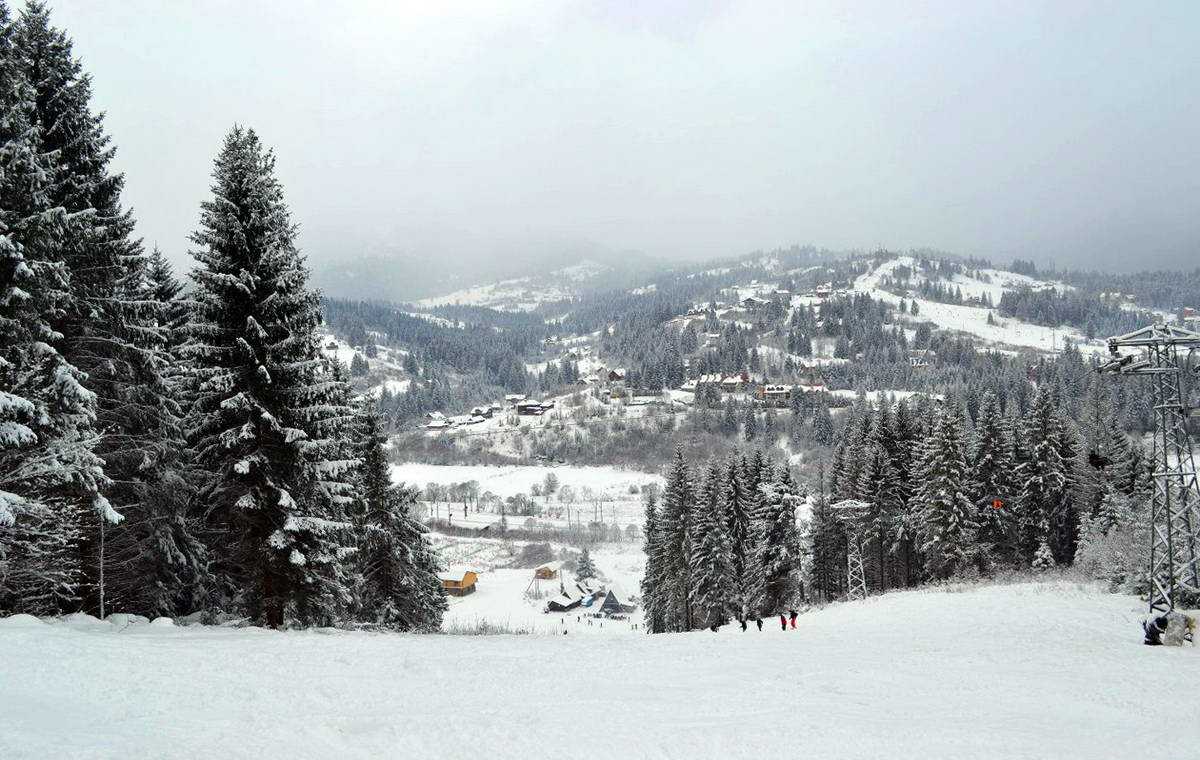
Every summer, Slavske is an art center that gathers plein air artists from all over Ukraine under the free Carpathian sky.
It is worth a visit:
- You should definitely see with your own eyes the unrecognized 8th wonder of Ukraine - the cave "Pysana Krynytsia". This is a cave where a spring that never freezes gurgles without interruption. The name of the cave is associated with a legend about the main character Oleksa Dovbush. Once, one of the leader's comrades decided to test his strength against him. But Oleksa was much wiser than his friend and did not want to start a fight, but instead offered to sign on the stone. Whoever managed to do it won. Unfortunately, none of Oleksa's brothers could do this, except for him. So Dovbush easily left his signature on the stone and won the bet. Since then, the locals believe that if you drink water from that well, you will have the same strength as Oleksa. The route to the peaks of Zvorets and Vysokyi Verkh passes through the "Pysana Krynytsia". This is a well-trodden path that will allow you to get acquainted with the local beauty of the Carpathian Mountains in one day. The length of the route is 15 km, so it's more like a pleasant walk than a difficult journey through the mountains.
- Lake Khashchovanske. Surrounded by mountains and meadows, it is located just 2 km from the village. There is a bridge on the lake that leads directly to the center of the reservoir, to a small island. Fishermen often go fishing here, and ecotourism fans admire the picturesque scenery. There are few tourists here, which makes the lake even more attractive.
- Kamianka Waterfall. It is located 35 km from Slavske. You will have to take a bus or train to Skole and walk from there. The entrance to the territory is paid, but the amount is quite symbolic. The place is very picturesque, and there are 2 other attractions nearby - a mineral spring with healing water and Lake Zhuravlyne (which the locals nicknamed "Dead"), rich in hydrogen sulfide. On the territory of the waterfall you can have a picnic and go horseback riding, fishing or swimming in the cold mountain waters. A small souvenir market is located next to the river, where you can also buy kebabs, Carpathian wine and mead.
- Tustan Nature Reserve. Located 58 km from Slavske, in the village of Urych. To get there, you have to take a train or a train going to Uzhhorod, get off at Skole or Stryi stations, and then take a bus to the village. A colorful festival dedicated to the Middle Ages is held there in August. You will be able to feel like a real opryshok and see with your own eyes the difficult living conditions of the famous leader Dovbush in the wild. The ruins of the ancient fortress of Tustan are a national monument of archeology, history and ancient Russian architecture. The territory of the historical and cultural reserve is quite extensive, and there is a historical museum in the village of Urych - the trip is definitely worth the time spent on the road.
- Pantheon. The grave of the UPA soldiers and victims of the national liberation movement of the 1940s and 1950s in Slavsk;
- Church of the Assumption of the Blessed Virgin Mary (1901), Slavske;
- Art Salon "MAKHIM", 23 Pryvokzalna St., Slavske.
Due to its favorable geographical location, there are many interesting places near Slavske that are worth visiting while in the Carpathians:
- Lake Vita
- Shypit waterfall;
- Rehabilitation center for brown bears;
- Lake Synevyr;
- Kamyanka waterfall;
- Lake Zhuravlyne;
- Tustan fortress;
- Mukachevo;
- Karpaty sanatorium (Schönborn Palace);
- Goshiv Monastery;
- Dovbush rocks.
Every year more and more foreigners visit Slavske. On many of the ski lifts, we have heard the Polish language more than once. Poles like to vacation here with their families. Most of them come to Ukraine by their own cars, as the roads in Lviv region are now as good as those in Poland. And it is only a little over 100 kilometers from Slavske to the border. Israel is much further away from Ukraine. But the number of Israeli tourists is increasing every year. Especially in the summer. Three direct flights a week between Lviv and Tel Aviv and active promotion of Lviv region in Israel have done their job. "We used to focus only on those who came to ski, but for several years now we have been getting more and more visitors who just want to relax in the Carpathian landscapes," says the administrator of the best hotel in Volosianka and Slavske, Vezha Vedmezha. Previously, most foreigners in Slavske were Russians, but now they are gradually being replaced by Polish and Israeli tourists.
With the development of the resort's infrastructure, the number of foreigners in Slavske will only increase. Volodymyr Beha, the new head of the Slavske united territorial community, is confident in this. The only condition is to improve the local infrastructure. "Local officials used to be reluctant to invite foreign delegations here, because they had to drive to the Vezha Vedmezha hotel over potholes," says Beha. "Today, as you can see, it takes about 10 minutes to get here, so I am sure that Slavske has a great future."
The modern ski resort Zakhar Berkut is located near Slavske. The resort's advantages: 14 red slopes; 19 blue slopes; a freeride track; 18 drag lifts; 2 chair lifts; a baby lift; the Maxim training ground (training track and drag lift); equipment rental; an artificial snowmaking system; a season ticket system; parking.
Almost every estate in Slavske has a sauna for 4-8 people (from 250 UAH/hour). One of the most popular wellness treatments is an open-air Carpathian vat with Carpathian herbs. Incredible relaxation, especially under the starry sky! And then you can treat yourself to tea with honey or blueberry jam. Pensions also have spas with classic treatments: wellness showers, baths, and massages.
Summer is also a time for traveling. There are many interesting things to do near Slavske. We suggest you go to the Skole Beskydy National Nature Park. There you will see the Carpathian waterfalls - Gurkalo, Sopit and Kamianetskyi, and Lake Zhuravlyne, which is also called Dead. While walking through the natural park, be sure to visit the medieval fortress of Tustan.
Fortunately, housing in Slavske can be found without any problems. The main thing is that there are offers that even students can afford. There are several types of accommodation in Slavske: comfortable hotels, cottages, and the private sector. It all depends on whether you are going to the ski resort alone or with a large group. If you and your friends decide to spend a weekend in Slavske, it will be more profitable for you to rent a small house, of which there are many in the town. Renting a cottage will cost you around 2000 hryvnias (per night). You can also stay in one of the hotels in Slavske. Hotel prices start from 350 to 1200 hryvnias. Another option is to rent a room in the private sector. It won't hit your pocket - you can rent a room for 100 hryvnias. You can find out more about housing in Slavske on our website. Please note: on holidays and in the winter season, the cost of rooms in hotels and cottages may be higher.
Які туристичні (пішохідні) маршрути проходять через/біля Slavske?
Пропонуємо пройти такі туристичні (пішохідні) маршрути через/біля Slavske: с. Славське, через Буковецький перевал до оз. Синевир, с. Тухля, через г. Маківка до смт. Славське, с. Дубина, чере вдсп. Кам'янка, г. Лопата, г. Матагів до с. Тухля, с. Либохори – г. Магура – с. Либохори, с. Либохора, через г. Матагів до с. Козаківка, с. Тухля, через г. Кіндрат, г. Матагів, г. Лопата, г. Кудрявець до м. Сколе
